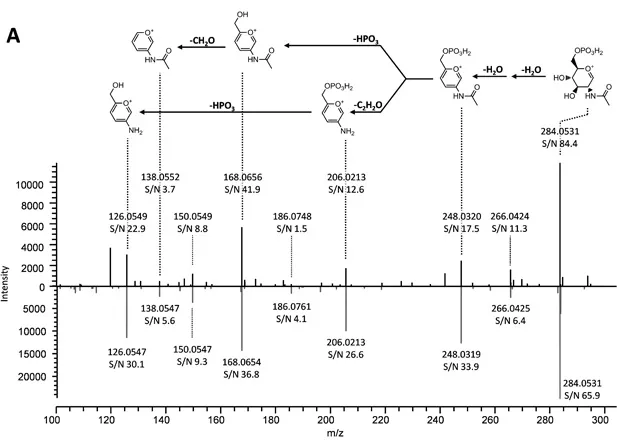Phosphorylated O-GlcNAc is a novel posttranslational modification that has so far only been found on the neuronal protein AP180 from the rat (Graham et al., J. Proteome Res. 2011, 10, 2725-33). Upon collision induced dissociation, the modification generates a highly mass deficient fragment ion (m/z 284.0530) that can be used as a reporter for the identification of phosphorylated O-GlcNAc. Using a publically available mouse brain phosphoproteome data set, we employed our recently developed Oscore software to re-evaluate high resolution/high accuracy tandem mass spectra and discovered the modification on 23 peptides corresponding to 11 mouse proteins. The systematic analysis of 220 candidate phosphoGlcNAc tandem mass spectra as well as a synthetic standard enabled the dissection of the major phosphoGlcNAc fragmentation pathways, suggesting that the modification is O-GlcNAc-6-phosphate. We find that the classical O-GlcNAc modification often exists on the same peptides indicating that O-GlcNAc-6-phosphate may biosynthetically arise in two steps involving the O-GlcNAc transferase and a currently unknown kinase. Many of the identified proteins are involved in synaptic transmission and for Ca2+/calmodulin kinase IV, the O-GlcNAc-6-phosphate modification was found in the vicinity of two autophosphorylation sites required for full activation of the kinase suggesting a potential regulatory role for O-GlcNAc-6-phosphate. By re-analysing mass spectrometric data from human embryonic and induced pluripotent stem cells, our study also identified Zinc finger protein 462 (ZNF462) as the first human O-GlcNAc-6-phosphate modified protein. Collectively, the data suggests that O-GlcNAc-6-phosphate is a general post-translation modification of mammalian proteins with a variety of possible cellular functions.
To MCP: www.mcponline.org
To the article: http://www.mcponline.org/content/11/10/1063
